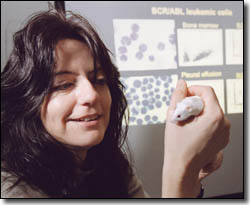Researchers Switch Cancer Off and On — In Mice

Claudia Huettner can switch off deadly leukemia in mice simply by putting an antibiotic in their drinking water. Her system even causes regression of advanced stages of the cancer. When the antibiotic-spiked water is withdrawn, the cancer returns.
Unfortunately, Huettner cannot do the same thing in humans. Nonetheless, she and her colleagues at Harvard Medical School have made some interesting and useful discoveries. Their on-and-off lab mice are advancing the understanding of how human leukemias arise, and providing a means by which new treatments for these malignancies can be easily tested.
For example, new drugs are being developed to prolong the lives of people with acute lymphoblastic leukemia (ALL), the most common bone marrow cancer in children. Experiments with mice that get an equivalent disease in the same way as children with ALL do by genetic mutation could speed up testing of these and other therapies designed to prolong the lives of ALL patients.
Such experiments aim at eliminating the mutated gene that initiates ALL-type leukemia. The same applies to chronic myelogenous leukemia, which occurs mainly among middle-aged and older people. If successful, Huettner speculates, “it may be possible to restore health and provide a longer life.”
The gene in question is known as BCR-ABL1. For the past 10-15 years, some of the best laboratories in the world have tried to genetically engineer mice that reliably develop leukemia in a way that makes it quick and easy to do experiments with them. None have succeeded. When Huettner decided to take on the challenge, she was advised that it was a difficult task and that failure could ruin her career. She persisted and, after two years of intensive work in the laboratory of Daniel Tenen at Harvards Institutes of Medicine, she won the game.
Delaying Death
This leukemia gene is actually a fusion of two genes, BCR and ABL1. The fusion occurs when the two get out of their normal positions on chromosomes inside a cell, a process called chromosomal translocation. BCR-ABL1 directs production of tyrosine kinease, which promotes a chaotic proliferation of white blood cells in the bone marrow. The leukemic cells migrate to the blood and invade the spleen, liver, brain, and other organs. When overwhelmed by these cells, the organs may stop functioning, and the risk of death becomes high. The mice die within a few weeks after BCR-ABL1 switches on.
In Huettners mice, the antibiotic tetracycline switches off the gene and its leukemia-producing activity. Cancer cells stop reproducing and begin to die. Simply adding the antibiotic leads to remission of leukemia that otherwise would be 100 percent lethal.
“I have induced then reversed cancer in some animals as much as three times,” Huettner says. “These mice are still alive; they are grandfathers and grandmothers now.”
In this way, the life of a model leukemic mouse can be extended, but it can never be saved because the animal still carries the mutant gene. Tetracycline in mice and tyrosine kinease drugs in humans can inhibit generation of leukemia, but they dont eliminate BCR-ABL1. If resistance to the inhibitor develops, either species will relapse with leukemia.
New tyrosine kinease inhibitors are now being tested on humans, but it remains to be proved that they can do the job alone. More effective treatments will probably involve combinations of the inhibitors with chemotherapy drugs, radiation, and bone marrow transplants. Such combinations must be tested on mice before being tried with humans.
The Harvard mice offer unique advantages for doing these tests. Huettner describes a scenario wherein a laboratory begins testing a therapy when a power failure or other emergency occurs. Researchers can simply give tetracycline to their subjects to arrest progression of the cancer. When experiments can be restarted, the antibiotic is withdrawn.
Working with reversible mice has also led to greater understanding of how cancer arises and maintains itself. For many years, cancer in general was believed to arise through a complex multistep process that involves several genetic abnormalities. Huettner and her colleagues have shown that a different scenario might do it, that is, some cancers might originate from and be maintained by a single genetic mistake.
“It was not known whether leukemia, once it began, needed the original mutation to maintain itself,” Huettner explains. “Now we know that the answer is yes for mice, and it appears that the same can be said for humans. Therefore, you would need to get rid of only one gene to effect a lasting cure for some leukemias and any other cancers that arise in this way.”
Huettners goal is to engineer mice with other diseases that closely mimic human maladies. On a more basic level, she studies natural cell death or apoptosis, wherein cells no longer of use to the body commit suicide. In leukemias and other cancers, diseased cells continue to grow and give rise to tumors. In her lab mice, when BCR-ABL1 activity is arrested by tetracycline, cell death proceeds normally, eliminating the leukemic cells.
Finally, there are the questions of how bone marrow, the source of all blood cells, forms in the first place, and how various mutations occur during this process. “The answers,” Huettner says, “are of prime importance for understanding both leukemia and the basic biology of human development.”




